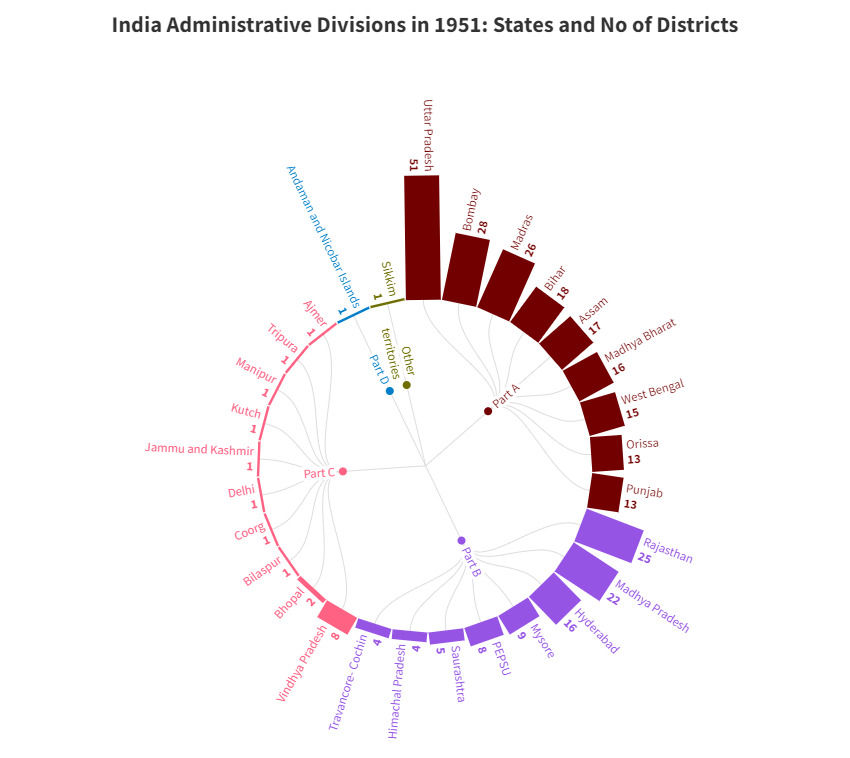India in 1951
- indiastatestories
- Jan 22
- 3 min read
Updated: Jun 17
By 1950, the political map and the status of administrative units in India had undergone a significant transformation compared to the situation at independence in 1947. The Government of India embarked on a rapid process of integration of 562 princely states, which was spearheaded by Sardar Patel and V. P. Menon, with the mandate to address the situation created by the impending lapse of paramountcy (Butlers Commission Report, 1927).
The integration involved rulers signing Instruments of Accession, initially ceding control over defence, external affairs, and communications. This was followed by Merger Agreements where rulers transferred full governing authority and jurisdiction to the Government of India, often in exchange for privy purses and other privileges. (White Paper 1950). By the time India became a republic with the commencement of its Constitution on 26 January 1950, the provinces and the princely states were consolidated and replaced with the fewer and larger administrative units classified into four categories, Part A, Part B, Part C, and Part D states.
This initial structure was largely a consequence of the integration of the princely states. The Instrument of Accession and the Merger Agreements were the key legal instruments that were used to bring these diverse entities into the Indian Union. The transition from the Dominion of India, under British rule, to the Republic of India/Bharat in 1950 was marked by the disappearance of the classifications based on ‘provinces, states and districts’ on the official map. It was primarily replaced by mentioning ‘states’ on the republic map within the Constitution, albeit still categorized as Part A, B, C and D (SRC report, 1955), representing an increasing degree of Central control.

This immediate post-independence structure was a hybrid system that integrated diverse entities such as British provinces and princely states into a single framework, with varying degrees of centralized control. Part A states (headed by Governors) are mainly 9 former governor provinces and the princely states within their geographic boundaries. Part B states are former large princely states or union of princely states, and were headed by Rajpramukhs. Part A and B states follow a federal model, though Part B states are subject to central oversight under Article 371, making them less autonomous. In contrast, Part C states (former Chief Commissioner provinces or some important princely states) were administered by the President through Chief Commissioners on a unitary basis. They had limited devolved powers under the Government of Part-C States Act, 1951. The only Part D state , Andaman and Nicobar Islands, were administered by the President through a Chief Commissioner although there was no provision for a legislative body or a Council of Ministers (SRC Committee Report, 1955; Fifteenth Report of the Second Administrative Reforms Commission - 2009).
Some territories within the geographical area of India, such as Sikkim, were not yet part of the Union or had unique statuses in 1951. Sikkim was treated as an Indian state but relations were handled through the external affairs department. Portuguese territories like Goa were still under Portuguese control, while Pondicherry remained in French control.

Although the demands for linguistic states existed at that time, the initial goal was to consolidate and maintain the existing administrative structures inherited from the British and incorporate princely states into the Indian Union (Tillin, 2013). The linguistic reorganization later in 1956 significantly altered this initial structure.
Although the major linguistic reorganization occurred later in 1956, demands for linguistic states were present in the early 1950s. The 1951 Congress manifesto acknowledged that people's wishes would play a role in reorganisation decisions, alongside other factors. Popular agitations in princely states facilitated their integration. Therefore, the principle for merging princely states did, however, consider the ethnic/linguistic affiliation of the majority population (Majeed 2003, Rai, 2012),
The map and status of Indian states in 1951 reflected a nation rapidly consolidating its territory after independence. The integration of the numerous princely states into a constitutionally defined federal structure, primarily driven by political necessity. While the redrawing of state boundaries continued to happen after 1951, the Indian Union was successful in the initial phase of unifying the political entity of India. (Chopra 2022)





Comments